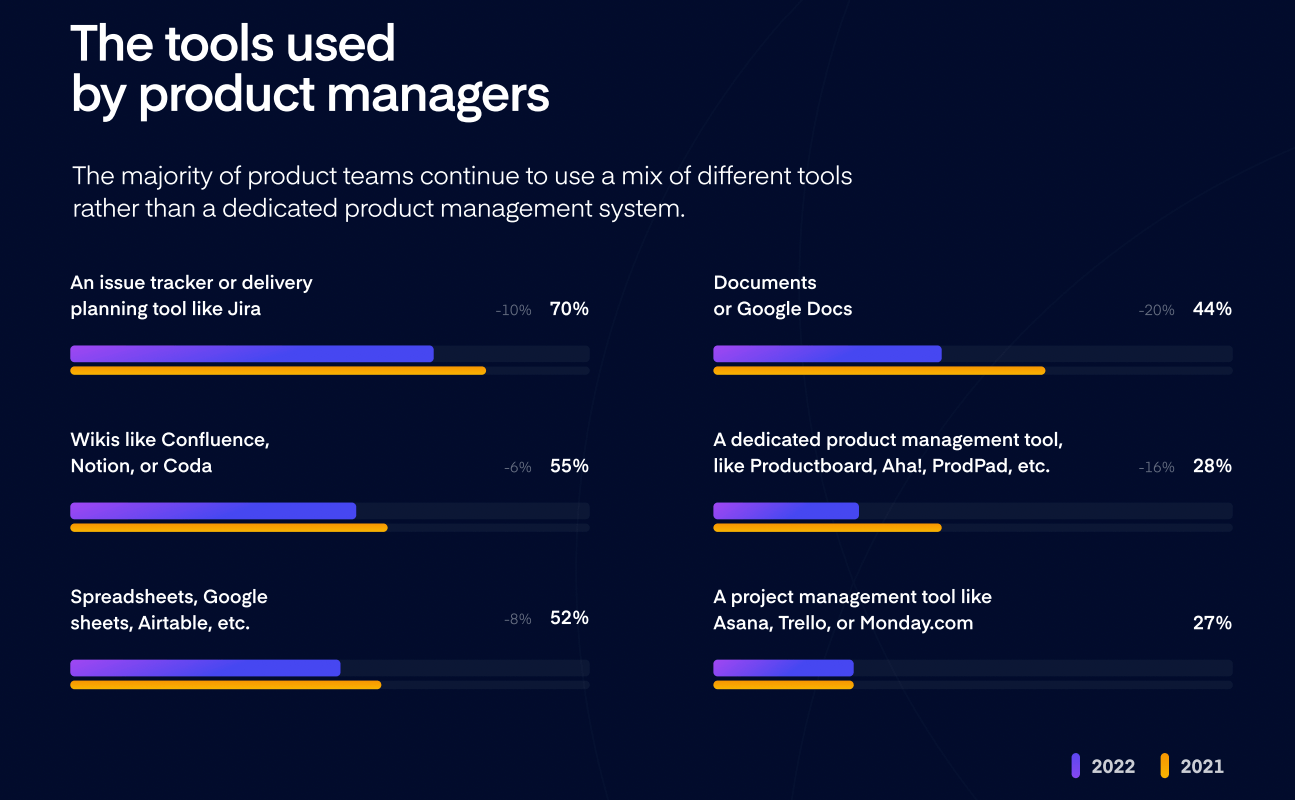The Problem With Spreadsheets – And Why High-Performing Product Teams Are Switching to Dynamic Software

Shenia, Group PM, creates a prioritization list for Harsha, Head of Product. She shares her prioritization list with other PMs, but the list not only looks different; it’s also prioritized by different key criteria.
Harsha has a very hard time consolidating 10 different teams spreadsheets – not to mention, the second he gets the spreadsheets, they’re immediately out of date. Harsha sees that at least six teams used strange criteria to prioritize (they are too silo-ed) and there is no way to track dependencies.
So sure, spreadsheets are free, if you don’t value your time.
The problem with spreadsheets
Spreadsheets are cost-effective and readily available, but they have a lot of limits when it comes to the complex job of product management and the amount of cross-collaboration it requires.
Here are just a few of the challenges product teams face in capturing feedback, prioritizing feature ideas, and everything else, in spreadsheets.
1. Spreadsheets have limited features (think metadata)
Yes, spreadsheets are flexible, but they are also incredibly basic. They don’t have any built-in key criteria to prioritize against, guiding best practices or product management-specific workflows – everything has to be built from scratch, manually updated, and as we touched on in the introduction, it’s immediately out of date. You cannot see duplicate work, or dependencies. There’s also the risk of lost knowledge if the architect of the team workflow leaves.
Imagine this scenario: you have a feature in a column in Excel. That metadata may not be the same as the columns in another team’s Excel – and it’s very unlikely that metadata comes up when you start a new priority list.
Adding any significant amount of customer feedback or user research can quickly lead to an unwieldy document. There’s no way to add supporting graphics, for example, so you have to upload them elsewhere and link them back in the doc. This spreads out vital information across increasingly complex systems, making it more difficult and less efficient for teams to do their work – and significantly increases the risk that vital information gets lost.
2. You have to customize them from scratch
Need to share your prioritized backlog with a specific stakeholder, but know they’ll get easily overwhelmed? If you want to share a spreadsheet with them, you have to make a copy and edit it down to feature only what they need to know. There’s also the risk that different teams are working on what turn out to be duplicate features, but given the wording of the feature, this isn’t discovered until it’s too late. A huge blow with limited resources available.
You now have another problem: no single source of truth. Different teams and stakeholders are passing around different versions of spreadsheets, making copies and altering them as needed. What happens if someone leaves the team for a new opportunity? Their versions could be lost forever, forcing teams to do duplicate work or miss out on vital information. A company reorganization could also mean starting from scratch when taking over that work, further wasting resources in a move meant to reconsolidate and increase efficiency.
3. They don’t play well with others
How many things in your tech stack integrate seamlessly with spreadsheets? Even if you’re using a SaaS solution like Google Sheets, you have to build the workflows that feed into it.
And while spreadsheets might feel collaborative, we’ve all known the horror of several people in a spreadsheet trying to update it at once. Sheer chaos. Tagging everyone who needs to be included in vital workflows is also an inefficient means of communication and you may have to duplicate that work in other systems to make sure nothing is dropped.
You’d never dream of replacing Salesforce or Jira with a spreadsheet, so why do product teams have to limit themselves when dedicated product management systems are available?
Why having a product management platform is mission-critical
As a product leader, we don’t have to tell you that the pressure is increasing to perform business-critical work, often with fewer resources. Your team’s focus must narrow to what’s vital, ensuring in turn that your product is mission-critical to your customers.
By now you’ve winced along with the major pain points associated with inadequate product team workflows. In a turbulent time, it’s especially important to maximize your resources and your team’s bandwidth, so that your workflows are able to scale.
That’s not how most teams are currently operating, unfortunately. Productboard recently commissioned Forrester Consulting to conduct a new study, The Business Impact Of Investing In Product Management, which found that while product management has increased responsibility in driving business outcomes, the investment in those teams doesn’t always match the expectations placed on them.
“The product management organization is using disparate tools to perform their work. When asked about the tools and technologies they use to do their jobs, respondents indicated that their time is fragmented across a variety of tools that may or may not interoperate.”
-2022 Forrester Consulting Study
Both this study and the 2022 Product Excellence Report found that product teams aren’t using purpose-built product management systems.

From the 2022 Product Excellence Report
As we’ve established, these hodgepodge systems fall short in ways that impact product teams’ ability to prioritize the right features and efficiently bring them to market. Here’s what a dedicated product management system can do for your team.
Rebuild (and scale) your product process
Do you have a workflow that everyone agrees on? If you’re using a bunch of disparate tools that don’t integrate well, chances are you do not. That’s the first step to rebuilding your process: be sure everyone agrees on what the process actually is, then write that down somewhere that is accessible to everyone where it can easily be updated as necessary.
Figuring out exactly what the product team’s function is at your organization is the second key to this, according to Josh Gibbs, VP of Product at Canto. Everyone needs to understand who you are and exactly what your responsibilities are, especially the stakeholders you and your team will need to work with the most. A product management solution makes all of this much easier.
Quickly prioritize features based on critical user needs
Now your product team has the “why” behind product development: user needs. Organizing features this way refocuses on the customer rather than on features as disconnected ideas. It also clarifies the path laid out for feature prioritization for not only the product team, but for the entire organization. Then everyone can see why you’re focused on building certain features over others, what objectives these features align to and how they ultimately help the business.
In Productboard, for example, you can do this with user impact scores, which show you the features requested by the most users. Drill down further into individual customer segments, such as: “Show me the top-requested features by Enterprise companies with more than 1,000 employees paying us more than $5k a month.”

The Features board allows you to sort ideas by user impact score and even filter to see what matters to specific segments, as defined by data from CRMs and product analytics solutions like Amplitude and Mixpanel.
Ted Burns, VP of Product at Propeller Health, said that success in his industry hinges on being able to identify the most pressing problems for customer segments with varying needs. After they implemented Productboard, product managers saw nearly 40 user requests for the same thing: a notification from a clinician-application showing when a patient had first synced their Propeller inhaler sensor with their phone.
“Seeing almost 40 Insight notes attached to a feature idea makes it really easy to point to as the thing to build next because you’ve had so many inbounds come in,” Ted says.
Easily share your product strategy with key stakeholders
A clear product strategy is essential to keeping a product-led organization on the same page. A dedicated product management system allows product teams to easily share high-level strategy across the organization, highlighting progress updates plus what releases and features are planned for the future.
Part of building a product-lead organization is empowering other teams in the product process; how can they help within the scope of their own roles? For example, customer-facing teams like customer support, sales, community and social teams are in the best position to gather and share customer feedback and insights to help the product team prioritize building the right features.
Create a single source of product truth, that easily scales
Remember that metadata we mentioned in relation to spreadsheets earlier? The great thing about a dedicated product management system is that any metadata that anyone has ever put about the feature will stay in the tool. This means if a product manager puts down that it’s a must-have for a customer, another PM who may be in charge of the feature will see it!
That’s simply not true of spreadsheets – or if a team manages to create a system that mostly compensates for this, it isn’t standardized or visible across teams. Work is at risk of being lost and has to constantly be replicated.
For example, in Productboard, every feature is tied to customer insights so everyone can understand why it’s crucial to build.
You can see dependencies to other features, you can see the owner and team, you can change the owner and team, other teams can follow the feature (a fantastic thing to have available if work needs to be taken over or duplicated, but not from scratch). A product manager or leader can also see any tags that any other product team member has assigned to it. This helps with roll-ups for product leaders (e.g. how many features do I have that are usability fixes vs. must have fixes).
Additionally, different releases can be set so you can see the feature on a detailed roadmap, or a higher level stakeholder roadmap. Product managers can also add tasks. And things can easily be pushed to Jira for seamless cross-team collaboration. There’s also the ability to add custom fields – like columns in Excel – but then see if anyone ever makes any updates. And those updates are automatically saved forever.
Product managers can also align to strategy – one of the biggest improvements over working out of spreadsheets! This also enables product leaders to look from features to objectives to see how much of the product strategy is on track to completion.
What’s more, other users who follow the features get updates on status progress automatically, giving product teams their time back updating key cross-team collaborators. A CSM following a feature to make sure their top customer ask is getting taken care of no longer has to be manually updated, for example.
As more teams work in some combination of in-person, hybrid and remote, it’s important to build workflows that will scale as teams scale. Spreadsheets definitely do not scale, as Drew Lau, Senior Director of Product Management at Salesforce noted in their story.
“You could use a bunch of Quips and spreadsheets and do that day to day,” Drew admits, “but that gets hard to scale once you get to four or five product managers all working together.”
How Productboard’s product management software can help you scale
Product work is complex and requires a lot of cross-functional collaboration, especially when it comes to building a product-led organization. When speed and efficiency are critical to success, you can’t have your team spending hours manually updating spreadsheets, double-checking access controls, and auditing every version for accuracy once it’s shared with key stakeholders.
Productboard’s dynamic software can be the key to your product team tackling the business critical work that’s expected of you, saving time, increasing release speed without compromising on quality, and maintaining progress even with personnel departures.
All of this is essential in increasingly turbulent times. Let us know if we can help.




